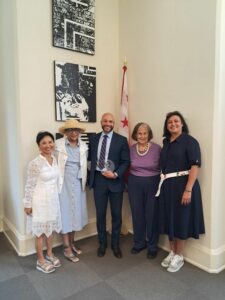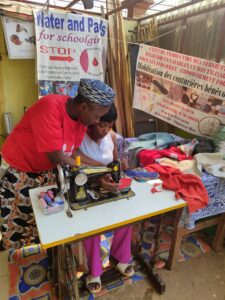The Canadian Federation of University Women continues the series on significant days to facilitate the conversation about the Sustainable Development Goals. Our purpose is to overlay a recognized Theme Day with the SDG lens in order to shine a light on, and bring the conversation to the grassroots level.
Annually CFUW participates in an International Women’s Day Project to highlight progress towards women’s equality in Canada and world-wide. It raises awareness about SDG #5 and the ongoing challenges and opportunity to celebrate women’s achievements. We believe by celebrating International Women’s Day with gusto we send a strong message that women will not be silenced, ignored or dismissed.
This is the seventh feature in the series of nine Theme Days (Mother’s Day, Father’s Day, World Day to end Human Trafficking, International Literacy Day, International Day of the Girl Child, National Day of Remembrance of Violence Against Women – Canada, International Women’s Day, Earth Day, and 50/50 Day). This initiative provides a critical opportunity to discuss the interconnectedness of the SDGs to achieve gender equality and empowerment of all women and girls. As well, we aspire to highlight the intersectionality of women’s issues and the need to engage all stakeholders in the conversation.
Achieving the 2030 Agenda is a challenge to all, and requires action at all levels. Recognizing that the priority theme of the United Nations Commission on the Status of Women this year is “Challenges and opportunities in achieving gender equality and the empowerment of rural women and girls”, our contributors have focussed on experiences of rural women. We hope you can connect to and extend the conversation beyond your circle.
__________________________________________________________________
Her Story is Important
I met her when she came in to register her daughter for kindergarten in public school. She made an impression as a woman of spunk because her ball cap had a marijauna leaf embroidered on it. This is not something you see in this setting everyday.
Her child started senior kindergarten. The only formal social situation she has been engaged in since she arrived in Canada. Twenty new classmates and two unfamiliar teachers to get acquainted with. Being a bright and curious child she picked up things easily.
Back to her black skinned mother, who was working the night shift at a factory and felt herself lucky because she had found a man to take her in and pledge to help her and her daughter get oriented in Canada. This twenty three year old mother had recently immigrated from a small island in the Caribbean to live with her sister, go to nursing school and raise her daughter in the snowy land of hope. The relationship with her sibling collapsed shortly after her arrival.
Into the school term I received a call on Thursday from her saying she was in a hotel because she had been removed from where she was living due to domestic violence. There were no beds available in the women’s shelter in town so the police put her up in the local motel. This single mother, with no support over the week end was moved to a shelter 175 km north of the urban area where she had settled. A rural area unfamiliar to her. She had no family connection there, no advocate and no input into the decision to transfer her and her daughter to a rural shelter.
The chances of securing an affordable apartment in town were slim but with her permission, I applied for subsidized housing for her and her daughter. Somehow she made it back to town to live with another single mother who also has a child. She pays $660 a month for one room. One has to keep in mind that her daughter did not attend school for 3 weeks while she was being bounced from motel to shelter to a one bedroom accommodation.
When they finally settled back in town she was outside the boundary of the school her daughter attended. To get to “her” school she would have to take two town buses and spend an hour, return trip, each day on the town bus. That would cost her $81 a month. $81 more than any other student in our school had to pay to get to school. Bussing is free to get to school if a family lives more than 1.3 km away from school. This was too much for a twenty three year old mother who works the night shift to get her five year old child to school every day! Understandably she decides to register her daughter at the neighbourhood school.
The registration secretary told her she had to have proof of address to register her child. She had just moved into the one room arrangement and had no lease agreement or other documentation that she lived in that area. Despondent and beaten, because she did not know her human rights, she decided to send her daughter back to the island of her birth to live with her father.
Four weeks after the report to the police of the physical and emotional abuse from her intimate partner, three moves and loss of time at work, her daughter was on a flight back to the Caribbean. Loss of dignity, loss of her child, and loss of her savings to pay for the plane fare, all in less than one month.
This got me to thinking that this story could have had a different outcome. A young woman who has no clue what her rights are is vulnerable to injustices that will change the course of her life. 1) She should have never been sent to a shelter in a remote area because she does not drive and had no advocate or services appropriate for her case. 2) Schools need to have provisions for registering families that are coming out of a shelter and do not have documents to show proof of address.
I can only image that the day she put her child on the plane was the lowest day of her life. It certainly was a low day for the small group who knew her story!
She has since returned to work. Her supervisor kept the job open for her while she was away. Two thumbs up for the supervisor! She says she feels like there is community there and is happy working there.
Why is her story important to tell? Her story is important because women without support from family or friends sink into a cycle of dysfunction. The biggest concern is will she ever be able to overcome and realize her dream of becoming a nurse. If she were rich, financially independent, educated and had community she would have been able to establish herself in a home, start her studies in nursing and support her child. Instead she has to depend on a system that did not have her in mind. Her dream remains in embryo.
She reminds me of Maya Angelou who told the following story to an audience at the Air Canada Centre in Toronto, “In 1945 the United Nations was advertising for simultaneous translators. I wanted so badly to be a simultaneous translator, the only trouble was, I was poor, black, pregnant, seventeen and uneducated”. Maya Angelou went on in June 1995, to deliver her poem, “A Brave and Startling Truth”, which commemorated the 50th anniversary of the United Nations. I hope this young woman’s story in the end will be as inspiring. The same way my cousin and I were excited to go hear Dr. Maya Angelou speak I wish that she will have an audience hanging on her every word and that her daughter will grow up to be phenomenal as well!
Cheryl Hayles
VP International Relations, Canadian Federation of University Women,
Vice President North America, International Alliance of Women
_________________________________________________________________
The Challenge of being a Rural Woman in Canada
The plight of rural women and their struggles are not well understood by those who live in larger urban areas around the world. This is perfectly evident to those who have experienced both rural and urban life in Canada and abroad. Certainly there are wonderful advantages in Canada for lovers of animals and nature, an unpolluted and healthy environment, a slower, relaxed and quiet life style, the satisfactions of a close-knit, friendly and caring community, and of producing one’s own safe food, all mentioned in a survey.
CFUW sent this survey to all clubs in Canada designing it to collect data on members’ perceptions and experiences in preparation for the Commission on the Status of Women (UNCSW62) and its theme of challenges for rural women. The answers were illuminating.
In response to the question “What are the two greatest challenges to life in rural communities?” the majority listed transportation as their number one problem. Almost all the other answers were variations on this. Many pointed out that long distances cause a lack of access to services, health services being number one. (This has been exacerbated by the closing of hospitals in smaller towns and specialists become increasingly limited to urban “hubs”). Others listed in order of frequency were: lack of access to employment, education opportunities, social, recreational and cultural opportunities as well as child care.
The second highest category was also linked to the distance involved in keeping in touch with others, the physical isolation and loneliness being mentioned by a majority of the respondents to this question. This included the lack of access to mental health services, affordable access to hi-speed internet and Wi-Fi as well as the insecurity involved in the time required to get emergency help in the case of fire, sickness or injury, and especially for women, crime and violence against women.
Economics was the next highest challenge. Limited choice in shopping for essentials such as groceries, the high cost of car maintenance necessary to access essential services, the higher costs of hydro, garbage disposal, septic systems and snow removal were included. Longer work hours with less return, and the lack of vacations or holidays were challenges as well as affordable housing. (Access to affordable housing or land purchase is decreasing with urban sprawl taking over former farm land. This has led not only to lack of housing but to increasing property taxes in rural areas as they become annexed to large municipalities.)
The last category with fewer comments was more nebulous but certainly important. This was a general feeling that the work and life of rural women were neither understood nor appreciated by the general public and even the government. There is a prevailing feeling of discrimination, stereotyping, sexism or patriarchy, and lack of appreciation or support for the rural population.
This is especially true in regards to public transportation for rural areas where trains and buses were rated “accessible with challenges” or “inaccessible” by the majority. In my own area there is the feeling that rural areas are neglected while large cities and urban metropoles receive a disproportionate amount of transportation funding.
Another problem in my own rural area, but not included in the survey, is the anguish of many local families whose elementary and high schools are also being centralized in large urban areas. This marginalizes the rural families. Their very vocal protests decry the long school bus ride, the distance involved making it difficult for rural families to attend school events. The necessity of catching the school bus home makes it impossible for rural students to attend after-school sports or events, or to join clubs including drama, and music. This further marginalizes rural families. Their argument that their local rural schools provide a sense of community and serve as community centres for both recreation and meetings, consistently falls on deaf ears and their schools are closed. A similar situation exists when small hospitals in rural areas are closed, leading to a loss of security for those with transportation issues, especially in winter when rural roads may be closed.
In order to foster and encourage the rural woman, we need solutions, especially to the problem of transportation for the young, the elderly, those with disabilities and those who cannot afford cars. Our clubs can make a difference. For example, CFUW Stratford in Ontario won a CFUW award for advocacy for its work on re-establishing train service for their rural area.
The St. Thomas CFUW club also supported a public meeting on transportation. From that has grown a large transportation committee headed by the Health Care Centre. Along with the VON, the Health Care Centre provides volunteer drivers for health appointments, but, being widely unknown, the service is under-utilized. This is a problem all across Canada borne out by the results of the survey. The overwhelming majority of the answers to the question on accessibility of volunteer drivers was “Don’t know” or “No information on this.” The local committee is working on acquiring a computer program for shared rides by commuters from rural areas to the city, as well as a centralized telephone number (perhaps a reference librarian) with an explanation of service organizations’ programs for affordable rides from volunteer drivers. Uber is not generally accessible in rural areas.
The transportation issue also presents a problem for rural members in CFUW. Not only does travel to meetings become challenging, travel to provincial, national and international meetings is difficult and expensive. This results in less voice and fewer votes than the larger clubs in urban areas. Their district representatives have longer distances to travel between clubs making personal visits and communication more difficult, especially in areas where computer access is limited.
Hopefully, the data from this survey, shared with an executive summary, will inspire CFUW clubs everywhere to share the information, to become more aware of rural issues, and to participate in advocacy and programs to further empower rural women and girls throughout Canada.
Nancy Mayberry, Ph.D., Member of the International Relations Committee, Canadian Federation of University Women
________________________________________________________________
Rural Women Survey for Organizations, sister survey to the Rural Women Survey
This survey was conducted by CFUW January 15 – February 15, 2018. Community organizations in Africa, India, United States of America and Canada responded to the questions. Of the 85 responses, the majority are from the provinces of British Columbia – representing multiple communities, Alberta, Saskatchewan, Ontario and New Brunswick. The 3 international responses came from Rwanda, USA – a Native American Band and India.
The survey had 24 questions. However, only two will be high lighted at this time.
Question:
How you define a rural woman?
“In our context, a rural area is a place or area with no modern or better infrastructure for example; no access to modern roads, running/piped water, no modern markets or shopping malls, schools, hospitals. A rural woman in this case is one who hails or lives in the kind of place explained above. A rural woman in our context depends on agriculture for food in her household and is limited to access to modern development processes”. Rwanda
“Women who live a place that is defined by its geography and its challenges. Having to travel (long distances) to access services therefore, where the risk of isolation is high because of roads, weather, natural disasters, etc.”. Canada
“As varied as a city woman”. Canada
“A woman living in a both peaceful (and risky) environment –is quite isolated with limited access to convenience, safety and support”. Canada
Question:
What are the opportunities in living in a rural community?
“More laid back, not the same hustle and bustle of city life, cheaper accommodations. People know each other or at least know off others”. Canada
“There can be a tremendous amount of community support for anyone experiencing a crisis. It can create a strong sense of ‘belonging’ which is important for health”. Canada
“Women can feel more supported by organizations that work together to provide wrap around services. Oftentimes, they will be remembered by service providers and addressed by name (rather than number or can’t recall them because the organization is too big)”. Canada
“Rural areas may be good if girls, women, boys and men had access to all services. In the absence of those services as it is today, I don’t see any opportunity of living in our rural areas”. India
“Inherently rural women are having basic specialized traditional skill with family background. Physically they are fit and fine who can work very hard”. Rwanda
In summary, it is clear that a rural community provides both opportunities and challenges for women and girls. In attempting to isolate the markers of each we found that the opportunities are related to a well developed sense of community created through interaction with others, culture and nature. Unfortunately, the challenges are all related to isolation and lack of gender based services which if they were community based would increase empowerment and promote a heightened state of emotional, physical and mental well-being.
Cheryl Hayles
VP International Relations, Canadian Federation of University Women
Vice President North America, International Alliance of Women



